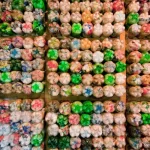Creating stunning wall art from recycled materials is an inspiring way to decorate your home. It blends creativity with sustainability and gives new life to items that might otherwise be discarded.
From old frames and magazines to bottle caps and fabric scraps, the possibilities are endless. This approach keeps costs low while reducing environmental impact.
In this guide, you’ll learn how to design eye-catching wall decor using what you already have at home. Let’s get started!
Why Use Recycled Materials for Wall Art?
Wall art made from reused materials offers more than just visual appeal.
It reduces landfill waste and encourages creative thinking. You’ll often find beauty in unexpected places.
This method supports eco-conscious living without sacrificing style or originality.
It also makes for meaningful handmade gifts or conversation-starting pieces in your space.
And best of all, it’s accessible—no special tools or expensive supplies needed.
Choosing the Right Materials
Start by exploring what you already own. Many household items can be transformed into unique wall art.
Here are some common recyclable materials to consider:
- Old picture frames and broken mirrors
- Scrap wood, cardboard, or pallet planks
- Bottle caps, jar lids, and metal tins
- Fabric scraps, old clothes, or denim
- Magazines, newspapers, and wrapping paper
- Broken jewelry, buttons, or beads
- Cans, wire, or plastic containers
Choose materials based on texture, color, and shape. Think about how they can combine to form patterns or images.
The goal is to repurpose creatively—not just to reuse, but to reimagine.
Tools You’ll Need
Before starting your project, gather the following basic tools:
- Scissors or craft knife
- Hot glue gun and glue sticks
- Paintbrushes and acrylic paints
- Mod Podge or clear sealant
- Hammer and small nails (if framing)
- Staple gun (for fabric-covered panels)
- Measuring tape and pencil
- Canvas board or wooden panel base
- Optional: drill, sandpaper, or spray paint
Using what you already have helps keep costs low and supports a zero-waste mindset.
Step-by-Step Guide to Making DIY Wall Art
Follow these steps to create personalized, sustainable wall decor from everyday items.
Step 1: Plan Your Design
Sketch a rough idea of what you want your artwork to look like.
Consider themes like nature, geometric shapes, or abstract designs.
Decide whether you want a single focal piece or a gallery-style arrangement.
Use Pinterest or Instagram for inspiration, but aim to make it uniquely yours.
Planning ahead saves time and avoids unnecessary waste.
Step 2: Prepare Your Base
Choose a sturdy surface for your artwork. Options include:
- Canvas boards
- Wooden panels
- Stretched fabric over frames
- Repurposed doors or shutters
- Masonite sheets or corkboard
Clean the surface thoroughly before starting. Sand if necessary.
If using wood, apply a light coat of primer or paint to create a uniform background.
This step ensures your final piece looks polished and professional.
Step 3: Arrange and Attach Elements
Lay out your materials on the base before gluing anything permanently.
Try different layouts until you find one that feels balanced and visually pleasing.
Once satisfied, begin attaching elements using a hot glue gun or strong adhesive.
For heavier items like bottle caps or wood pieces, reinforce with small nails or screws.
Take your time—this is where your creativity shines.
Step 4: Add Color and Texture
Enhance your wall art with paint, ink, or other decorative touches.
Acrylic paints work well on most surfaces and dry quickly.
Try techniques like dry brushing, sponging, or splatter painting for depth.
You can also add metallic accents with gold or silver pens.
Layer textures by combining different materials like fabric, paper, and metal.
Don’t be afraid to experiment—mistakes can lead to beautiful surprises.
Step 5: Seal and Protect
Once your artwork is complete, apply a protective sealant.
Mod Podge, clear varnish, or spray sealers help preserve your creation.
They also prevent dust buildup and make cleaning easier.
Apply at least two coats, allowing each to dry fully between layers.
This ensures durability and longevity, especially in high-traffic areas.
Creative Ideas to Inspire You
Looking for inspiration? Here are some imaginative ways to use recycled materials in wall art:
1. Bottle Cap Mosaic
Arrange colorful bottle caps in a pattern or image. Glue them onto a wooden board and seal with epoxy resin for a glossy finish.
2. Magazine Strip Collage
Cut old magazine pages into thin strips. Twist or fold them to create 3D floral or abstract designs on canvas.
3. Denim Patchwork Wall Hanging
Stitch together scrap denim pieces to create a soft, textured wall hanging. Add lace or embroidery for extra detail.
4. Framed Fabric Panels
Stretch old scarves, tablecloths, or clothing over wooden frames. Hang individually or as part of a gallery wall.
5. Newspaper Word Art
Cut words or letters from newspapers and arrange them into motivational quotes or names. Frame for a personal touch.
6. Button Portrait
Use vintage buttons in varying sizes and colors to create a portrait or abstract face. Attach to a painted canvas.
7. Cardboard Geometric Shapes
Cut cardboard into triangles, hexagons, or circles. Paint and layer them for a modern, dimensional wall display.
Each idea brings character and sustainability into your space.
Tips for Long-Lasting Results
To ensure your wall art stays beautiful for years:
- Use quality adhesives and sealants.
- Avoid direct sunlight to prevent fading.
- Dust regularly with a soft cloth or brush.
- Reinforce heavy elements with screws or brackets.
- Store unused materials in dry, organized spaces.
With proper care, your DIY wall art will remain vibrant and meaningful.
Final Thoughts
DIY wall art made from recycled materials combines creativity, sustainability, and personal expression.
By transforming everyday objects into striking decor, you reduce waste and add unique charm to your home.
Whether you’re decorating your own space or creating a gift, the process is deeply satisfying.
Let your imagination lead the way—and enjoy the beauty of giving new life to old things.
Start today, and see how simple materials can become extraordinary works of art.



